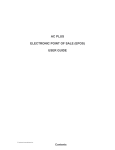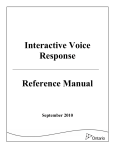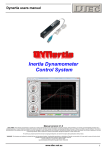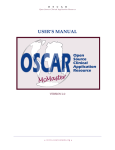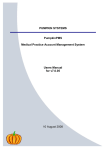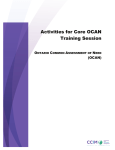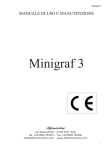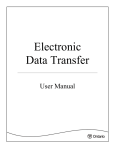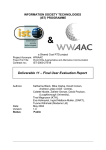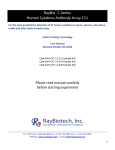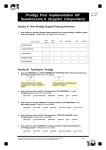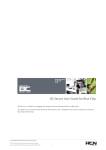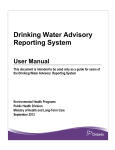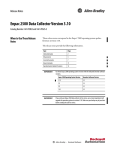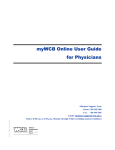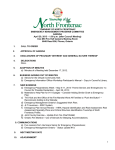Download Electronic Data Transfer
Transcript
Electronic Data Transfer Guidebook EDT GUIDEBOOK All possible measures are exerted to ensure accuracy of the contents of this manual; however, the guidebook may contain typographical or printing errors. The public is cautioned against complete reliance upon the contents here of without confirming the accuracy and currency of the information contained herein. The crown in Right of Ontario, as represented by the Minister of Health and Long-Term Care, assumes no responsibility for any person’s use of the material herein or any costs or damages associated with such use. Ministry of Health and Long-Term Care Registration and Claims Branch Business Operations and Claims May 2004 www.health.gov.on.ca (i) EDT GUIDEBOOK W elcome to the Ministry of Health and Long-Term Care’s Guidebook to the Electronic Data Transfer (EDT) service. This guidebook has been written to help you prepare and register for EDT. It contains the following information: benefits of EDT claims processing and payment scheduling how to register for EDT list and explanation of technical requirements questions to ask your software vendor glossary of terminology ( ii ) EDT GUIDEBOOK ♦ TABLE OF CONTENTS ♦ INTRODUCTION What is the EDT Service? ..........................................................................................................1 How Does EDT Work?...............................................................................................................2 BENEFITS of EDT Fee-for-Service Medical Claims ................................................................................................3 Overnight Batch Eligibility Checking (OBEC) ..........................................................................4 More Benefits! ...........................................................................................................................5 EDT PROCESSING and PAYMENT SCHEDULE INFORMATION EDT Claims Submission Cut-off Date .......................................................................................6 Submission of Supporting Documentation ................................................................................6 EDT Claims Reports (Output) Schedules...................................................................................6 Overnight Batch Eligibility Checking Processing Schedule .....................................................8 TECHNICAL REQUIREMENTS and REGISTERING for EDT 1. 2. 3. 4. Contact Your Software Vendor ............................................................................................9 Review the Technical Requirements with Your Software Vendor.....................................10 EDT Access .........................................................................................................................14 Contact MOHLTC for an EDT Registration Package ...........................................................14 EDT TECHNICAL SUPPORT Ministry of Health and Long-Term Care .................................................................................17 Software Vendor ......................................................................................................................18 GLOSSARY Glossary ...................................................................................................................................19 ( iii ) EDT GUIDEBOOK ♦ INTRODUCTION ♦ What is the EDT Service? The Electronic Data Transfer (EDT) service is a vehicle for the electronic transmission of files from your personal computer (PC) to the ministry’s mainframe computer. EDT has specific technical requirements and is accessed either via a long distance direct dial telephone call or through Bell Canada Datapac lines. EDT uses the Government of Ontario Network (GONet). EDT is a secure method of sending and receiving information. Only authorized users with a registered EDT User ID and password can access the ministry’s EDT service. There are currently two applications within the EDT service that the ministry offers: Fee-for-Service Medical Claims This application replaces your current diskette, tape or paper claims submission method. Submit your file of fee-for-service medical claims for processing via EDT. In turn, your claims reports (Batch Edit, Error Report and Remittance Advice) are sent electronically to your EDT mailbox. You can also send and receive electronic files to and from other registered EDT users. Overnight Batch Eligibility Checking (OBEC) The OBEC application enables providers to verify the eligibility/status of a health number/version code before a health service is provided. A formatted file of health numbers/version codes is sent. The file is processed and eligibility verified via the ministry’s Registered Persons Data Base (RPDB). The ministry then returns a file of corresponding response codes. OBEC response codes are the same as those used by the ministry’s other validation programs; Interactive Voice Response (IVR) and Health Card Reader (HCR). Oculo visual assessment codes are only available through IVR at this time. Other applications will be added to the EDT service in the future. INTRODUCTION ♦ 1 ♦ MAY 2004 EDT GUIDEBOOK How Does EDT Work? Many of you send and receive information now using e-mail and the Internet, EDT works similarly. Through specific technical requirements (refer to section Technical Requirements and Registering for EDT) you can use your PC to transmit claims directly to the ministry. Users connect to the EDT service using communication software, a modem, and telephone line capable of handling data communications. Users log onto the EDT service using their assigned EDT User ID and password in order to upload (send) files containing claims or OBEC data to the ministry. Claims related reports and OBEC response files from the ministry are sent electronically to the users EDT mailbox. Users must then log on to the EDT service to download (receive) these files from the ministry. Files must first be downloaded before they can be read by the users billing software or read by the users OBEC application software. Electronic Data Transfer - Upload and Download INTRODUCTION ♦ 2 ♦ MAY 2004 EDT GUIDEBOOK ♦ BENEFITS of EDT ♦ Fee-for-Service Medical Claims Convenience Send your files anytime. The EDT service is available 24 hours a day, 7 days a week except when occasional system maintenance is scheduled between 5:00 am and 8:00 am on Sunday mornings. Faster Error Correction and Resubmission Your communication software gives an immediate confirmation message of the successful transfer of your file. An error message is given if the file transfer is unsuccessful and the file must be resubmitted. Prompt notification is sent if the file is not accepted. Within a few hours the ministry will send a File Reject Message if the claims file was unacceptable. You can therefore resubmit this file most likely during the same monthly cycle. You receive fast notification of claims batch rejections. Usually within 24 hours a Batch Edit Report is sent to detail the acceptance or rejection of your claim batches. Quick receipt of Error Reports allows you to reconcile errors and resubmit claims faster. Error Reports are normally sent within 48 hours of claims file submission. You can resubmit rejected claims, often during the same monthly payment cycle. Automated Error Reconciliation EDT Error Reports are sent in machine readable format so your billing software can be programmed to provide automated reconciliation. Earlier Monthly Reconciliation EDT Remittance Advices are available earlier (usually between the 5th and 7th of the month) which allows prompt reconciliation of accounts. BENEFITS of EDT ♦ 3 ♦ MAY 2004 EDT GUIDEBOOK Fee-for-Service Medical Claims (Continued) Direct Your Claims Output Each claims report can be delivered to any valid EDT User ID. For example, if you share administrative support or use a billing agent, you may wish to direct your claim reports to an EDT User ID other than your own. You can do this by completing Part C of the Application for GONet EDT Service (form 3274-84). No More Diskettes, Paper Claims or Reports EDT eliminates the need for exchanging diskettes, tapes or paper claims. EDT also eliminates the need for arranging for the delivery of diskettes, paper claims or tapes and the courier or postal costs associated with that activity. Files are not manually handled via EDT so there is a reduced likelihood of files being lost/misplaced or damaged during delivery. Locums You can use the same EDT User ID to submit claims for services rendered by you anywhere in the province. Your output will always be directed to the User ID specified by you when you registered for EDT. You can send files to your own EDT User ID and access the information from a second location as long as the location meets the EDT technical requirements. This eliminates the need to carry diskettes or the risk of disks being lost/stolen or corrupted. Overnight Batch Eligibility Checking (OBEC) OBEC is a helpful tool used to validate the health number before a health service is provided, reducing the potential for claim rejection. It complements but should not replace point of service validation, (Health Card Reader and Interactive Voice Response) as health cards should be presented at each visit. Check Health Number Before Health Service You can identify ineligible health number/version codes before a service is provided. This may be particularly useful when a patient is referred, coming from out-of-town or a patient has had claims rejected in the past. BENEFITS of EDT ♦ 4 ♦ MAY 2004 EDT GUIDEBOOK Overnight Batch Eligibility Checking (OBEC) (Continued) Fast Return of Response Codes Files received by the ministry by 4:00 pm are processed overnight and the responses returned to the submitter by 7:00 am the next business day. Validate Next Day Entire Patient List With OBEC you can submit all your next day’s appointments for validation in one file. Save Staff Time Daily use of OBEC allows your staff to clear up any health number discrepancies with your patients before or during their office visit identifying where direct billing may be necessary. More Benefits! User-to-User Benefits EDT provides a secure environment to transfer files between EDT users. It may be faster to use EDT to transmit large files instead of faxing the information. For example, if you need to send medical information to a colleague and they are a registered EDT user, EDT is a fast, secure and efficient method of transmission. Simplify or Eliminate Manual Processes You can simplify and possibly eliminate manual processes in your office by using EDT. Your software can be programmed so that starting the submission of electronic files can be as simple as a “touch of a button”. Some vendors may refer to this process as “scripting”. The ministry does not recommend programming/scripting the password process. Multiple Practice Locations Access to the EDT service is available from any location with your own EDT User ID and password provided the computer system meets the EDT technical requirements. BENEFITS of EDT ♦ 5 ♦ MAY 2004 EDT GUIDEBOOK ♦ EDT PROCESSING and PAYMENT SCHEDULE INFORMATION ♦ This section provides claims processing and payment related information including an explanation and schedule of claims reports. Contact your local ministry office with any business inquiries concerning payment or non-payment of specific claims. EDT Claims Submission Cut-off Date The cut-off date for EDT claims submission is the 18th of the month. EDT claims received after the 18th may be processed until the month-end mainframe computer cut-off date, where time and volumes permit. Submission of Supporting Documentation Supporting documentation must be delivered to your local ministry office. It is important that supporting documentation be mailed or faxed the same day the file is transferred since EDT provides quick transmission of claims files. The ministry is investigating the transfer of supporting documentation using the EDT service. EDT Claims Reports (Output) Schedules EDT claims reports (output) are delivered to the EDT User ID specified by you in Part C of the Application for GONet EDT Service. IMPORTANT: You must regularly log on to the EDT service and download these files to your PC where your billing software can read them. Check regularly for these reports. They are the only notification you will receive of rejected files, batches or claims from the ministry. Rejected files, batches and claims must be resubmitted to be considered for payment. A copy of these downloaded files are kept by EDT for 5 days. You can download again if necessary, for example, if your report became corrupted or lost. These copies of the downloaded files will be deleted after the 5 days. Claims and user-to-user files not downloaded expire in 95 days and will be deleted. EDT PROCESSING and PAYMENT ♦ 6 ♦ MAY 2004 EDT GUIDEBOOK EDT Claims Reports (Output) Schedules (Continued) Types of EDT Claims Output File Reject Messages notify you if the ministry has rejected an entire claims file. This notification is normally sent within a few hours of claims file submission. Claims Batch Edit Reports notify you of the acceptance or rejection of claim batches. This notification is normally sent within 24 hours of claims file submission. If claims are uploaded on a weekend, holiday or at month-end, the Batch Edit Report is delivered on the next claims processing day. Claims Error Reports notify you of rejected claims. This notification is normally sent within 48 hours of claims file submission. If claims are uploaded on a weekend, holiday or at month-end, the Error Report is delivered at the end of the next claims processing day. Remittance Advices (RAs) are produced during a three-to-four day period at the end of the month and are delivered when month-end processing is completed. EDT RAs are normally delivered between the 5th and the 7th day of the month. Stoppage of Paper and Diskette Reports For three months after you register for EDT, the ministry will send claims outputs in both EDT and your current format. Three months after EDT registration ALL paper and diskette claim output reports will be stopped. Claims output reports will be sent via EDT only. Payment Payment schedules and methods will not change when you register for the EDT service. Locums Registered EDT user’s claims output will be sent through EDT no matter what claims submission method is used. For example, if a fee-for-service medical claim is submitted for you on diskette your output will still be sent to you through EDT. EDT PROCESSING and PAYMENT ♦ 7 ♦ MAY 2004 EDT GUIDEBOOK Overnight Batch Eligibility Checking Processing Schedule Processing Schedule Overnight Batch Eligibility Checking (OBEC) files received by 4:00 pm are processed overnight and responses returned to the submitter by 7:00 am the next business day. There is a limit of 50,000 records per file. Eligibility is checked based on the date the file is submitted. OBEC does not guarantee payment or provide the correct health number or version code. Response Files Your input file naming convention determines the type of response you will receive. There are two types of response files available: to receive a response file containing only those health number/version codes that are invalid, files submitted should be named OBECE xxx.ttt. to receive a response file containing one record for each record submitted, files submitted should be named OBECA xxx.ttt. ‘xxx’ can be any valid alphabetic or numeric character or can be omitted. ‘ttt’ is DAT or TXT for normal (ASCII) files. Files that do not follow the naming convention documented in the Technical Specification Interface to Health Care Systems manual will result in a file containing one record for each record submitted. Your vendor should have a copy of this manual. OBEC response files not downloaded expire in 7 days and will be deleted. EDT PROCESSING and PAYMENT ♦ 8 ♦ MAY 2004 EDT GUIDEBOOK ♦ TECHNICAL REQUIREMENTS and REGISTERING for EDT ♦ This section explains the EDT technical requirements and the four steps you must take in preparation to register for the EDT service: 1. Contact Your Software Vendor If you are looking for a software vendor or switching vendors you may wish to consider the following suggestions: Contact your professional association for a list of vendors Talk to your colleagues who have already registered for EDT Request that your vendor supply a list of clients for reference The Ministry of Health and Long-Term Care does not provide a list of vendors. Suggested Vendor Software Change Questions: Can you upgrade my current billing software to read and create the new file formats necessary for EDT and have the capability to send billing and validation files and process Error Reports and Remittance Advice files? How long will it take to upgrade my billing software? If you cannot upgrade my current billing package do you have a billing software package that will give me what I need for EDT? Do you sell the other communication equipment that I need for EDT? Suggested Vendor Training Questions: Do you provide training? Is the training included in the purchase or upgrade price? How many staff members will receive training? Is there a time limit on the training? Is the training available in the future? Are manuals provided? Are they easy to understand? Suggested Vendor Support Questions: What type of support is included? (on site, toll-free number, hours of support) What is the cost? (service contract, charge for travel time, other charges) TECHNICAL REQUIREMENTS ♦ 9 ♦ MAY 2004 EDT GUIDEBOOK 2. Review the Technical Requirements with Your Software Vendor Review the following technical requirements for EDT with your vendor. The minimum requirements necessary to use EDT, as well as enhancements you may want to discuss with your vendor are located within this section, under “Your EDT Checklist” and “Technical Enhancements”. Information on all file layouts required for EDT can be found in the Technical Specifications Interface to Health Systems manual. Your vendor should already have a copy of this manual. Software Changes to Billing Software for Output Files Changes are required to your current billing software in order to use the EDT fee-for-service claims application. These changes are required to receive and process the following EDT claims output files: EDT File Reject Message EDT Claims Batch Edit Report EDT Claims Error Report Changes to your billing software may also be required because you may be accessing the Remittance Advice (RA) from a different drive. EDT Overnight Batch Eligibility Checking (OBEC) To use the EDT OBEC application, you will require software to create the OBEC input file and to process the OBEC output file. Communications Software Communications software must be installed on your personal computer (PC). It is used to facilitate the sending and receiving of files through a modem. The package that you select must have a file transfer protocol of ZMODEM, YMODEM, XMODEM or KERMIT. Compression Software Compression software may be a future requirement. The ministry may send Remittance Advice files in a compressed format in the future. Advance notification of the implementation of compression and the specific software required will be provided as soon as it is available. TECHNICAL REQUIREMENTS ♦ 10 ♦ MAY 2004 EDT GUIDEBOOK 2. Review the Technical Requirements with Your Software Vendor (Continued) Hardware Modem Your personal computer will need either an internal or external modem. Vendor Enhancements Your vendor may offer the following enhancements to the minimum EDT requirements. Programming/Scripting: Many communication software packages allow users to automate the communications process. You or your vendor can script files to automatically upload or download files on the EDT service. The ministry recommends that if your scripting bypasses manual log on, you still familiarize yourself with that process. It is important that you know how to log on and change your password. The ministry does not recommend scripting for password changes. For more information, refer to the EDT User Manual, section 11, General Information. Uploads that miss a ministry processing deadline because of failure of automated scripts are the user’s responsibility. Automated Reconciliation: Your software can be programmed to provide automated reconciliation of claims output files. It can also be automated for submission and reconciliation of OBEC files. TECHNICAL REQUIREMENTS ♦ 11 ♦ MAY 2004 EDT GUIDEBOOK 2. Review the Technical Requirements with Your Software Vendor (Continued) Your EDT Checklist These are the Minimum EDT Technical Requirements: Your fee-for-service claims software must be able to: Create a machine-readable claims input file Process the machine-readable File Reject Message Process the machine-readable Claims Batch Edit Report Process the machine-readable Error Report Process the machine-readable Remittance Advice Your OBEC software must be able to: Create a machine-readable OBEC input file Process the machine-readable OBEC response file Your telephone line must be capable of handling data communications. Your communications software must have: One of the required file protocols (ZMODEM, YMODEM, XMODEM or KERMIT) Choose one of these access methods: 1. Long Distance Direct Dialing (ministry recommended) Requirements are: A modem The telephone numbers for the production and test environments will be provided after EDT registration. OR 2. Datapac Requirements are: A Datapac Network User Identifier (NUI). For more information, contact your local Datapac office. A modem TECHNICAL REQUIREMENTS ♦ 12 ♦ MAY 2004 EDT GUIDEBOOK 2. Review the Technical Requirements with Your Software Vendor (Continued) Technical Enhancements: Your software can be further programmed for: Automated reconciliation of batches from the Claims Batch Edit Report Automated reconciliation of rejected claims from the Error Report Automated reconciliation of the Remittance Advice Automated submission of OBEC files on a regular basis Your Communications software can be “scripted” to: Enable unattended access to upload or download files Ask your vendor if the software comes with: Training: Is training available? Cost? Support: Is support available? Onsite? Toll-free number? 24 hour service? Other Enhancements: _________________________________________________________ _________________________________________________________ ___________________________________________________ TECHNICAL REQUIREMENTS ♦ 13 ♦ MAY 2004 EDT GUIDEBOOK 3. EDT Access Choose your access method to the EDT Service: 1. Direct Dial Access (ministry recommended) Supports up to 56k modem Connects directly to the GONet log on screen Requires no set-up fees or monthly administrative fees (long distance charges from your location to Kingston will apply) You can choose the long distance carrier with the best rate The telephone number for the production environment will be provided after EDT registration. The telephone number for the test environment will be provided after EDT registration. 2. The other access to the EDT service is through Bell Canada Datapac. You must contact a Datapac business office to register for a Datapac Network User Identifier (NUI). There is a one-time registration fee to obtain this NUI and it will be used to bill you monthly. Datapac is older technology with a maximum transfer speed of 9600 baud. 4. Contact MOHLTC for an EDT Registration Package To obtain EDT registration information and applications contact the EDT Help Desk at 1 800 262-6524 (refer to section EDT Technical Support). Our staff will send you a registration package. They can also answer your EDT questions. Here are the steps to register for EDT service: 1. Contact the ministry EDT Help Desk at 1 800 262-6524 to request a registration package. 2. Complete the Application for GONet Electronic Data Transfer (EDT) Service (form 3274-84) and EDT Undertaking and Acknowledgement (form 3279-84). Return the completed forms to the ministry address shown on the form. TECHNICAL REQUIREMENTS ♦ 14 ♦ MAY 2004 EDT GUIDEBOOK 4. Contact MOHLTC for an EDT Registration Package (Continued) IMPORTANT: Have your billing software upgrade and communication connections ready BEFORE registering for EDT. To assist you in the transition to EDT, for three months after registration, the ministry will send claims outputs via both EDT and your current format. Three months after EDT registration, paper and diskette reports will be stopped and only EDT outputs will be sent. 3. Wait for notification from the ministry that EDT privileges have been activated. You will receive an EDT User ID (GONet ID) with an initial temporary password, an EDT User Manual and a Notification of Change for GONET Electronic Data Transfer (form 3277-84) for any future changes such as a new address. NOTE: Part C of the EDT application form gives you the opportunity to direct your output reports to any valid EDT User ID. For example, if a billing agent reconciles your claims, your output files could be sent to that EDT User ID. If completing “Part D: Overnight Batch Eligibility Checking (OBEC)”, please note that OBEC is not available to billing agents at this time. Registering a Provider Group The provider group must complete one Application for GONet Electronic Data Transfer (EDT) Service (form 3274-84) and one Undertaking and Acknowledgement. Each affiliate of the group must sign the EDT Undertaking and Acknowledgement (form 3279-84). The Electronic Data Transfer (EDT) Undertaking and Acknowledgement (form 3343-84) can be used for additional signatures, if required. Provider groups receive one EDT User ID per group number. If you have a solo practice and are part of a group practice, you can register your solo practice for EDT and the group can register the group practice for EDT. The ministry will assign an EDT User ID for each. TECHNICAL REQUIREMENTS ♦ 15 ♦ MAY 2004 EDT GUIDEBOOK 4. Contact MOHLTC for an EDT Registration Package (Continued) Registering an Independent Health Facility (IHF) The IHF must complete one Application for GONet Electronic Data Transfer (EDT) Service (form 3274-84) and one Electronic Data Transfer (EDT) Undertaking and Acknowledgement (form 3279-84). Each provider affiliated with the IHF must sign the EDT Undertaking and Acknowledgement. New Providers and Paper Claim Submitters If you are a new provider or submit your claims on paper, you must submit a test file to your local ministry office before being approved for EDT claims submission. Call your local ministry office for more information. Security Code Word When completing the Application for GONet Electronic Data Transfer (EDT) Service (form 3274-84) you are required to select a security code word. It is essential that this code word be kept in a secure place and be easily remembered. This security code word is used to verify the identity of the caller contacting the ministry EDT Help Desk. It is recommended that the selected word be something you easily remember but avoid using a word that is easily identified with you. EDT Test Environment An EDT test environment is available. This environment allows testing of automated scripts for log on, log off, upload and download. It does not perform any tests or edits on files that are transferred and it does not produce any output reports. Contact the EDT Help Desk at 1 800 262-6524 for further information. TECHNICAL REQUIREMENTS ♦ 16 ♦ MAY 2004 EDT GUIDEBOOK ♦ EDT TECHNICAL SUPPORT ♦ Ministry of Health and Long-Term Care The ministry will send you an EDT User Manual that contains step-by-step instructions on how to use the EDT service when you are registered. The ministry has an EDT Help Desk to provide support to you and your staff. The toll-free number is: 1 800 262-6524 or in Kingston call 548-7981 The desk is staffed from 8:00 am until 5:00 pm, Monday to Friday, to answer technical questions pertaining to the EDT service. After business hours an answering service is available and your call will be returned the following business day. Should you make a call to the Help Desk you may be asked for the following information: name phone number MOHLTC provider number (MOHLTC billing number) EDT User ID unique security code word date and time the problem occurred summary of the question/problem and filename if applicable have you had this problem before Types of Calls for the EDT Help Desk I have forgotten my EDT User ID password. Could you please reset it? I’m having trouble downloading my RA. I submitted a claims file last night but the Batch Edit report is not in my mailbox. TECHNICAL REQUIREMENTS ♦ 17 ♦ MAY 2004 EDT GUIDEBOOK Ministry of Health and Long-Term Care (Continued) Business inquiries concerning payment or non-payment of specific claims should continue to be directed to your local ministry office. You may be asked for the following information: What is your billing number? What is your EDT User ID? Did you check your EDT mailbox for output reports? When did you submit your claims - date and time of upload? What is the name of the file? Software Vendor Any questions regarding your computer set-up should be referred to your vendor. Ask your vendor what kind of support they offer and if there are additional charges above the cost of the software for this support before purchasing your software. If your system uses “scripts” to automate log on and file transfers, problems with these activities should be directed to your software vendor. Ask Your Vendor: Can my communications software be scripted? Does my billing software read the new electronic claims related reports? TECHNICAL REQUIREMENTS ♦ 18 ♦ MAY 2004 EDT GUIDEBOOK ♦ GLOSSARY ♦ Baud Rate The speed at which data transfers between two devices, such as between two computers connected via a modem. Billing Agent An agent authorized by a health care provider, or a group of health care providers, to prepare their claims data on machine-readable media for processing by the ministry and/or to reconcile payment data on machine-readable media provided by the ministry. Bits Per Second (BPS) A measurement of data transmission speed. Communication Software A type of software used to establish a connection and exchange data with another computer. Compressed File A file that has been reduced in size by converting to a more compact format. Datapac A phone service offered by Bell Canada that provides (for a fee) the communication lines on which the file transfer data is sent through telephone lines from authorized users to the EDT computer. Downloading The process of receiving a file from another computer. Electronic Data Transfer An Ontario government service that allows authorized users to transfer files (via a modem and telephone line) from their computer to government mainframe computers. The ministry currently offers two EDT applications: fee-for-service medical claims and Overnight Batch Eligibility Checking (OBEC) of health cards. (EDT) File Transfer The process of using communications to move or transmit a file from one computer to another, using a protocol which has been agreed upon. File Transfer Protocol (FTP) A list of communications parameters (settings) and standards that govern the transfer of information among computers using telecommunications. Both computers must have the same settings and follow the same standards to avoid errors. Government of Ontario Network (GONet) The interface designed by the Ontario government that is used to upload/download (send/receive) files. GLOSSARY ♦ 19 ♦ MAY 2004 EDT GUIDEBOOK Log Off The process of terminating a connection with a computer system or peripheral device in an orderly fashion. Log On The process of establishing a connection with, or gaining access to, a computer system or peripheral device. Mailbox Users have a mailbox on the EDT service where files are sent from the ministry or other users. This mailbox can only be accessed by using the authorized ID and password. Files will remain in the mailbox until they are downloaded, deleted or expired. Modem A device that allows communication between two computers through telephone lines. Network User Identifier The Datapac NUI is issued by Bell Canada to allow users to access the GONet EDT service. The NUI is used to track use of the system for billing purposes. (NUI) Output A file sent from the ministry's mainframe in response to an input file. Overnight Batch Eligibility Checking (OBEC) Allows an authorized user to electronically send a formatted file of health numbers/version codes to the ministry for validation before a health service is provided. Password A security tool used to identify authorized users of a computer program or computer network and to define their privileges, such as read-only, reading and writing or file copying. Protocol A set of standards for exchanging information between two computer systems or two computer devices. Report A printed output that usually is formatted with page numbers and headings. Script Files A program written to automate the communications process to allow unattended access when uploading or downloading. An automated script may include the keystrokes necessary to log on, upload, download and log off. Security Code Word A confidential word selected by the user to assist in verifying the user to the ministry. Upload The process of sending a file to another computer. User Identification Access to the EDT service is restricted to authorized users with the appropriate ID and password. (User ID) GLOSSARY ♦ 20 ♦ MAY 2004
























